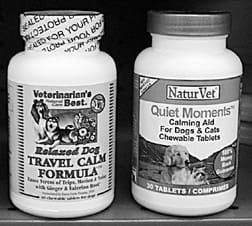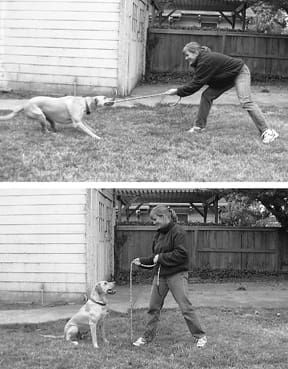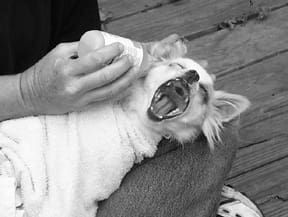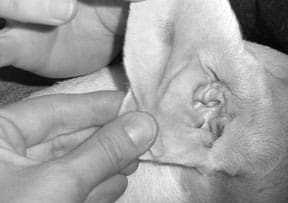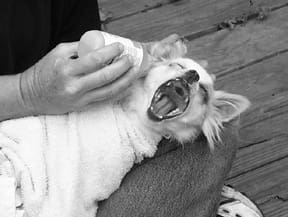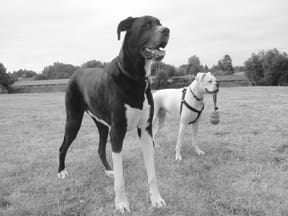[Updated January 28, 2019]
The idea is shocking to many dog owners: Their dog’s food can make him sick? Of course it can – all foods, whether intended for humans or pets, can be dangerous if they were improperly manufactured or stored. It’s interesting, however, how few people suspect their dog’s food when he becomes ill, especially if they have been feeding the same food for years and years.
It’s nice that some companies have engendered such loyalty – to be held above suspicion in the face of evidence to the contrary! – but the fact is, manufacturing accidents can and do happen.
Far more frequently, though, foods can become harmful to your dog’s health due to poor handling or storage practices.
If you are aware of the potential dangers of tainted dog food, and know how to prevent them or rapidly respond to them, your dog should be safe from harm.
Dog Food Manufacturing Problems
Despite the fact that we’ve all heard horror stories about glass shards found in jars of baby food or deep-fried rodents in an order of takeout chicken, few people seem to be aware that their dog’s food could contain hazards, too. But accidents do happen. Every pet food maker has war stories to tell about disasters they averted (sometimes at great cost) and smaller-scale quality-control failures that cost them clients. A partial list of the most common things that can go wrong in the production of dog food include:
• Spoiled or tainted ingredients are used, including rancid fats, spoiled proteins, and/or moldy grains. Some molds excrete toxins (collectively called mycotoxins); some mycotoxins, such as vomitoxin, can make dogs very ill. Others, such as aflatoxin, can kill. (See “Hidden Killers in Dog Food,” WDJ July 2000.)
• Ingredients are included in excessive (toxic) amounts, including vitamin/mineral premixes, preservatives, coloring agents
• Ingredients that are not supposed to be in a formula are included by error (this is dangerous to a dog with a severe allergy to an ingredient that is not on the product label)
• Foreign object contamination: plastic, glass, metal, rodents, insects, pesticides, cleaning agents
• The food doesn’t “cook” at adequate temperatures to result in a complete bacterial kill
• The plant’s equipment is not cleaned adequately or frequently enough, resulting in contaminated product
• An inadequately dried dry food, resulting in the growth of mold in the bags.
Even so, dog owners should understand that manufacturers are highly motivated to produce the best, most consistent products possible. Problems that escape detection until they end up in a dog’s bowl somewhere are the stuff of manufacturers’ nightmares. This is especially true for companies who aim their efforts at the top end of the pet food market. Failure to deliver a less-than-perfectly manufactured product is especially wounding to those who have spent fortunes on “human grade” ingredients and whose literature promises the best results.
And, fortunately, most of the potential manufacturing problems are prevented or corrected and kept from harming dogs by the manufacturers’ mile-long list of hazard analysis and quality control procedures. Frankly, inspections of manufacturing plants by state officials are infrequent, but it behooves plant operators (especially facilities that manufacture high-quality, high-priced foods) to pursue certification by more stringent inspectors, such as the American Institute of Baking.
However, if you are aware that problems with dog food production can and do occur, you can take steps that may prevent those problems from inflicting harm to your dog.
Look for Fresh Products
We’ve said this before but it bears repeating: When buying naturally preserved foods (like the kind we recommend in WDJ), look for products bearing “best if used by” dates that are at least a year away. Most dog food manufacturers use “best by” dates that are 18 to 24 months from product manufacture. You (and your dog!) want fresher products than that.
Some companies print dates of manufacture on the label, in addition to the “best if used by” dates and their coded information; we love that. And don’t buy food that is close to its “best if used by” date.
If the Food Doesn’t Look Right, It Probably Isn’t
First and foremost, it’s important to withhold any food from your dog that doesn’t look right. The presence of foreign objects, a coating of powdery or hairy mold, and even a significant deviation from the food’s usual color can signify something amiss with the food’s production.
If you see anything unusual about your dog’s regular food, call the maker’s toll-free number, printed on the bag or can of most commercial foods, and talk to a representative about it. (If the package does not list a phone number for the maker, call the retailer that sold you the food and enlist his help in reaching the manufacturer. Usually, the retailer will have a number for his salesperson, who will work quickly to put you in touch with his employer.)
The company should be able to provide an explanation and offer remediation. First, though, they will need to confirm that you do, in fact, have some of their food. To do this, they will need information from the product label so they can determine when and where the food was made. For this reason, you must have and keep the bag or can until you have fed all the product it contains.
The importance of this cannot be overstated. “Without the date-code information (from the label), the manufacturer is totally blind,” says Russell Armstrong, president and co-founder of VeRus Pet Foods, of Abingdon, Maryland. In fact, he adds, every food maker has had the experience of trying to deal with a dog owner who insists their pet became ill after eating the company’s food, but who can provide no proof of ever having purchased it.
If, in contrast, an owner is able to provide a food maker with the date-code information from the food in question, the maker can check its database for any other reports of problems with that batch. If an investigation is needed, the maker can even go to its storehouse of samples from that batch and have them examined and/or tested for the irregularity seen by the dog owner.
“I require my manufacturers to pull samples from every 1,000 pounds of product,” says Frank Cook, vice president of Natural Balance Pet Foods Inc., of Pacoima, California. “Usually, for our products, our co-packer (contracted manufacturer) runs about 80,000 pounds (in a batch). I have them pull two samples every 1,000 pounds. One is tested, and one is shelved for the lifespan of the product. Should there be any problem with that product down the road, we always have a sample to test.”
Often, in the case of a foreign object in the food or food that is suspected in making a dog ill, the maker will ask the consumer to send the remainder of the product back to the company for testing and analysis. This needs to be done, but the consumer should be a little cautious, warns Armstrong. “I think it’s important to send the manufacturer some of the food – or the foreign object, if that’s what the trouble is. But you should realize that once you send it away, you don’t have it anymore, and if a legal problem arises, you are going to wish you had your evidence back,” says Armstrong.
His recommendation is to send just some of the suspect food back to the maker. In the case of a foreign object, take pictures or other documentation. “That way, if the manufacturer fails to test it, or reports that everything was perfectly fine, and you are skeptical or concerned whether you are getting the right answer, at least you have some product that you could send out for testing yourself,” Armstrong advises.
Armstrong takes the approach that well-informed customers are the happiest and safest customers, so he encourages owners to let the company know about any anomaly seen in VeRus’ products. In the best case scenario, he says, a call to the maker will calm the consumer’s fears and educate them a little more about their dog’s food.
“Even small things are worth a call to the maker,” he says. “For example, if you notice discoloration in the product – it could be indicative of mold or rancidity, or it could be something innocuous. A change from winter wheat to summer wheat (or vice versa) can cause minor coloration changes; switching from dark meat to white meat can cause a kibble to change in color. Even changing the die on the extruder that shapes the food can make the appearance of the kibble change in size and color. Manufacturers should be able to give answers to those sorts of questions easily,” he says.
Ceasing to feed the suspect food and contacting the manufacturer can also help the maker identify a lethal problem more quickly, potentially saving dogs’ lives. L. Phillips Brown, DVM, technical advisor for Newman’s Own Organics, of Aptos, California, says that all reputable pet food makers maintain a database of information about every report made by a client.
As the keeper of the “adverse events” database for Newman’s Own Organics, Dr. Brown is in the perfect position to detect any trend that developed with a defective product, and take immediate action to analyze the problem. “The faster people contact us and let us know about problems, the quicker we could solve them, if need be,” he says.
If the Dog Food Doesn’t Smell Right…
If a food looks fine but smells bad when you open it – and, especially, if your dog seems reluctant or slow to dig into it – it’s likely that the food’s preservative and antioxidant agents have not performed as well as they should. The fats in the food may be rancid, making it unappealing, but not necessarily unhealthful. Oxidation of the fats in a food can result in a chemical chain reaction that leads to a rapid spreading of free radicals (peroxidation or auto-oxidation). The absorption of essential fatty acids and fat-soluble vitamins is significantly reduced in oxidized foods – defeating the purpose of buying that costly nutritious diet!
If a food is giving off a strong, chemical or rancid odor, it’s probably not dangerous to feed to your dog, but it’s certainly not what the manufacturer intended. “If it doesn’t smell right, you shouldn’t feed it,” advises Armstrong. “My experience is, if a food is rancid, a dog won’t eat it, even if he’s a real chow hound.”
Armstrong and several other pet food company executives admit that all makers of naturally preserved foods struggle with the task of preventing rancidity and oxidation in their products. “The one downside of natural preservation systems is that sometimes shelf life is shortened,” says Dr. Brown. “Still, it’s better than putting chemicals and artificial preservatives into our animals’ tissues.”
“In my opinion, the good food makers are all using natural preservatives, not BHA, BHT, or ethoxyquin. It is harder to preserve your food with natural preservatives, however; and it is more expensive,” agrees Cook. “But there are a number of reasons for rancidity besides the failure of the manufacturer to get enough vitamin A or C in there. I’d guess that 99 percent is a storage issue. It could be a problem at the distribution level, such as improper stock rotation. It could be improper storage at the retail level, or, most likely, a problem in your home storage method.”
Proper Kibble Storage is Important
Plastic Containers
The best way to store dry dog food is in its original bag, which is placed in a clean, airtight container to prevent insect or rodent contamination. Many people like to dump food out of the bag into another container. If you feel you must, make sure you buy a container made of FDA-approved food-grade plastic. All other plastic containers can leach the vitamin C out of the food into the plastic, speeding oxidation of the food and reducing its nutrient content.
No matter what type of preservatives are used in your dog’s food, it can quickly turn rancid if exposed to oxygen and hot temperatures. Every dog owner should know proper food storage procedures, but very few take the time to locate (or allocate) a storage space in their homes that won’t expose the food to dangerously high temperatures. Dog food is supposed to be stored “in a cool, dry place.” That’s not the garage, in many parts of the country.
“Where I live in southern California, my garage gets up to 110 degrees,” says Cook. “Put that food into a plastic container out in the garage and you are just asking for trouble.”
Plastic containers seem to be the bane of dog food manufacturers. Every representative we spoke to had horror stories that shared elements of plastic storage containers and sick dogs. They recognize that storing the food and scooping from the bag can be a hassle, especially with big bags, but suggest that the bag is the best, safest place for the food.
“Dog food bags were designed to prevent anything from either entering into the food or exiting from the food,” explains Armstrong. “And the wrong type of plastic can actually speed the decay of the food. Some plastics can actually absorb much of the vitamin C out of the food; it leaches out and is sucked right into the plastic material. This, of course, affects the shelf life of the food; with the low levels of antioxidant vitamin C, the fat starts to oxidize and this accelerates the spoilage. It’s kind of like when you put tomato sauce in a plastic storage container, and you see the red residue in the plastic even after you wash it. That tells you the plastic is not ‘food-quality.’ ”
Cook emphasizes the hazard of unwashed plastic containers. “Many people dump new, fresh food on top of the remnants of old, rancid food. Those remnants of oxidizing old food can speed the oxidation of the new food,” he warns. Cook also prefers that owners keep dry food in its original bag, but if they have a food-grade plastic container, he recommends that they wash it out well and allow it to dry thoroughly before putting fresh food in it.
According to Armstrong, metal containers (such as trash cans) don’t necessarily cause spoilage, but they can affect the taste of the food. “It’s always best to leave the food in the bag, even if you keep the bag in a metal can to prevent rodents from getting in it,” he says. Plus, this solution keeps the date-code information handy. “If your dog has any sort of health problem while eating that food, you can quickly find the information the manufacturer will need to know to help identify the problem,” Armstrong advises.
What to Expect from the Pet Food Maker
“Honesty.” That’s what Armstrong says is what an informed consumer should expect from a company to whom they are reporting an adverse health event possibly linked to its food. “The company should be as straightforward with the dog owner as possible. If they have received other reports similar to the one the consumer is making, they should tell the owner about the other reports,” he says. Comparing information may help the owners’ veterinarians treat affected dogs.
In return, however, Armstrong expects the consumer to be able to report critical data about the food in question. “First, we need the date code from the bag of food,” he says. “If it’s a date code we’ve had any complaints about, we’ll let them know. Next, we’ll want to know where they bought the food – which store exactly, so we will be able to contact that store and alert them to possible problems. We’ll also need to know how long they’ve had the food, how much they have fed to their dog, and what the dog’s symptoms are. If they took their dog to the veterinarian, I need to know the vet’s name and phone number because I need to contact them.”
After gathering all the needed information, and asking for some of the suspect food (if needed), Armstrong tells the dog’s owner what he is going to do about the problem. “I let them know we’re going to send the food out for testing with the comparative product samples, and that I’ll let them know what the findings were. If they would like to return that bag to their retailer and exchange it, I encourage them to do so, but I ask them to please retain some of the product and the date-code information.”
Sometimes the problem is obvious, and tests are not needed to identify the cause of distress in the dogs that ate affected product. This was the case in one of the largest adverse events in the pet food industry, the Nature’s Recipe vomitoxin affair in 1995. Frank Cook, now vice president at Natural Balance Pet Foods, Inc., was then the vice president of Nature’s Recipe. “We identified the problem immediately,” he says. “It wasn’t difficult to recognize it as vomitoxin (a toxin excreted by a mold growing on grain) because vomitoxin makes the dog vomit. And our consumers were all saying, ‘Hey, my dog is throwing up!’ ”
Cook and the other executives at the company announced a massive recall of the food – some 16,000 tons of food that were scattered all over the U.S., Asia, and Europe, at a total cost of over $20 million dollars. They also hired a public relations firm (actually, the same outfit that helped Johnson & Johnson get through the Tylenol tampering murders in the early 1980s) to help them handle the resolution of the problem. The PR firm suggested that Nature’s Recipe should vigorously protect its good name by rushing uncontaminated product to every consumer who might possess affected product. “Every time someone called in with a complaint, we FedExed them a fresh bag the very next day,” says Cook. “It was very costly, and the event set the company on its heels, but it survived, and I think the reason it did was because we reacted so rapidly.”
Cook wryly admits that being an executive at the company during the event wasn’t the high point of his career, but adds, “We learned so much – and the whole industry learned with us. We learned a lot about the value of customer service, and how people will stick with you if you make things right as quickly as possible.”
The incident is undoubtedly why Cook is such a stickler for pulling so many samples from his current company’s production line, and why Natural Balance’s date-codes include a time of day in addition to the date. “If you pull a sample only from the beginning, middle, and end of a run, there is a lot of room for error in between,” he points out.
Cook also imposes stringent rules for the manufacture of his company’s product on his co-packers (manufacturers hired to produce his products). “My products don’t leave the manufacturing plant until the results of all the tests are in, to ensure there was no fat rancidity and the product meets all our specifications. I don’t think a lot of companies go that far, but having been on the other side of the fence, I wouldn’t do it any other way,” he says.
Repeated Mistakes in Kibble Manufacturing
There’s a big difference between a company whose products are frequently problematic and one that has suffered a one-time adverse event, no matter how tragic. We propose that the victim of a single event disaster may well be in the best position to learn every possible technique to prevent further accidents, and should not necessarily be punished by consumers, especially if the remediation efforts were swift, sincere, and generous.
In contrast, we’ve heard of companies that ship products with the same problems with their products year after year, and that offer little if any remediation to customers who complain. If we bought a bag of expensive, premium food and it was moldy, we’d expect an immediate replacement and an explanation. If, some months later, this happened again, we’d probably switch brands for good.
DOG FOOD GONE BAD: OVERVIEW
1. Buy fresh food. Check the “best if used by” date on the bag.
2. Visually inspect the food – it shouldn’t be dusty or moldy. Smell it – it shouldn’t smell rancid. Discuss any irregularity with the maker before you decide whether to feed it.
3. Store dry food in its original bag, in a cool, dry place. Ideally, keep the bag in an airtight container.
4. If your dog has an adverse health event that could possibly be related to the food, withdraw the food immediately. Contact the manufacturer and report the event as well as the product’s date-code. If the symptoms are serious, get your dog to a vet, fast, and put your vet in contact with the manufacturer.
5. Pay attention if your dog is reluctant or slow to eat his food. It may be rancid or oxidized.


